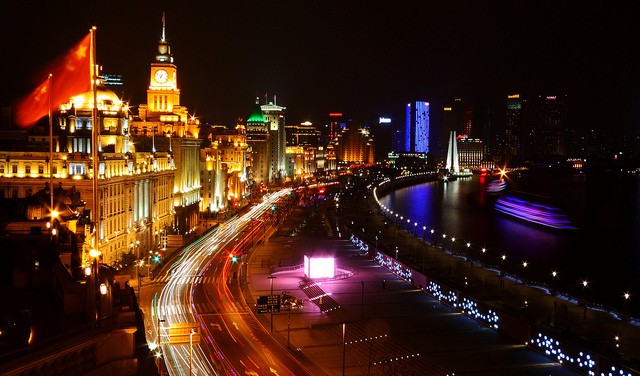
We caught of Monica Suma to get the scoop on Shanghai’s best kept secrets: Where to eat, stay and soak in the rich history of this Paris of the East.
On your first day here, seeing this is a must:
Shanghai has transformed so much in the past two decades, that some of its prior visitors might not recognize it anymore. To clearly appreciate Shanghai’s unbelievable boom, start no further than The Bund. Considered to be the face of Shanghai, it’s where the city gets divided by the Huangpu River in two districts: Puxi (West of the Huangpu) and Pudong (East of the Huangpu). The Bund is where people from all over the world come to see the impressive skyline overlooking Pudong, with striking skyscrapers rising faster than you can say Ni Hao.
 On the complete opposite spectrum, most buildings on the Bund’s extensive promenade in Puxi look just like they did during Shanghai’s 1920s and 1930s. Displaying a distinct European architectural style, with Art Deco and Neoclassical facades, it’s where the Old City starts. The Bund is also a must to visit at night, for its spectacle of hallucinating neon lights, preferably while enjoying a scenic boat tour on the Huangpu River.
On the complete opposite spectrum, most buildings on the Bund’s extensive promenade in Puxi look just like they did during Shanghai’s 1920s and 1930s. Displaying a distinct European architectural style, with Art Deco and Neoclassical facades, it’s where the Old City starts. The Bund is also a must to visit at night, for its spectacle of hallucinating neon lights, preferably while enjoying a scenic boat tour on the Huangpu River.
Most people don’t know this, but to get a true taste of the local culture”…
You have to spend an afternoon walking around The French Concession. A former French quarter from 1847 up until 1946, it developed during the 1920s into the premier residential area of Shanghai. It is now a splendid district with well-preserved European architecture and tree-lined streets reminiscent of Paris. The quaint alleyways and charismatic boutiques make the stroll delightfully charming, as if walking through Shanghai’s glory days of the 1930s.
For a glimpse of daily life, I recommend this form of transportation:
Nothing shrieks Shanghai more than the meeker bikes the locals are incessantly riding around town. In a metropolis of 23 million people, a large percentage of the population relies on them; the sheer concentration of bikes on the streets is staggering to the point that even a New Yorker might initially be reluctant to navigate through them. If you want to preserve your sanity, perhaps the subway is a better option. Apart from being overly crowded, the subway is by far the fastest and safest way to get somewhere. Given its novelty, it’s still one of the few public systems in the world that is clean. It’s intuitive and it’s equipped with English instructions.
 Taxis are also incredibly convenient, that’s if you don’t mind the rush of adrenaline you’ll get from their almost unlawful speed. In terms of communicating with your driver, who will most likely not understand a word of English, the Magic Number is your salvation. In each cab, you will find a sticker on the back of the driver’s seat that contains a very important number, which connects you to a free hotline. It’s one of the best travel innovations I’ve seen in a while; you simply dial, choose your desired language, mention the address to the phone representative and then hand the phone over to the taxi driver. They can also instruct you on how much the fare might cost, as well as how long it could take; it’s a lifesaver at the very least.
Taxis are also incredibly convenient, that’s if you don’t mind the rush of adrenaline you’ll get from their almost unlawful speed. In terms of communicating with your driver, who will most likely not understand a word of English, the Magic Number is your salvation. In each cab, you will find a sticker on the back of the driver’s seat that contains a very important number, which connects you to a free hotline. It’s one of the best travel innovations I’ve seen in a while; you simply dial, choose your desired language, mention the address to the phone representative and then hand the phone over to the taxi driver. They can also instruct you on how much the fare might cost, as well as how long it could take; it’s a lifesaver at the very least.
I had my best night’s sleep at:
Having stayed for a few weeks in Xuhui’s District Rayfont Hotel was one of the best decisions I made. Located in the lively Dapuqiao area, it is easily accessible to any of Shanghai’s main attractions. It’s a five-minute walk from the art district of Tian Zi Fang, and across the street from Tesco, a major supermarket. The hotel acts as a serviced apartments type of business, and for a great value, you get a spacious room with lots of amenities including, Wi-Fi access, your own bathroom, as well as a fully-equipped kitchen, a cozy living-room and balcony. It’s extremely convenient and significantly cheaper than you would expect for what you’re getting. It’s fun to learn to cook in a wok (sorry, no stoves in China), use a rice cooker and switch to tea instead of coffee. The views from the top floors of the hotel are also a huge bonus.
The meal at this local eatery had me salivating for days:
Without a doubt, Shanghai is best known for its soup dumplings (steamed pork dumplings) and for mastering the art of slurping. Street stalls selling delicious xiaolongbao, also known as baozi, can be found on every other corner. These steamed buns of Chinese goodness – essentially pork dumplings with a gulp of soup, wrapped up in a wonton wrapper – are cheap, melt in your mouth and are Shanghai’s foodies favorite subject of debate. It’s hard to pick a single eatery where the buns reign supreme, as it depends on what you like best: the thickness of the skin or the quality of the soup inside. However, as a rule of thumb, the humbler the restaurant, the better the buns; if the steamer baskets are worn out and you’re “kindly” pushed aside for the flow of waiting customers (locals), then expect some divine boazi.
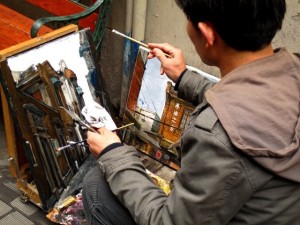 Best place to find artisan handicrafts…
Best place to find artisan handicrafts…
is undoubtedly in Tian Zi Fang. Known as “the warehouse of arts and crafts,” Tian Zi Fang feels intimate and friendly due to its narrow walkways. Not long ago destined for demolition and home to a grimy street bazaar, the once crumbling Shikumen houses and former factories were renovated, giving life to a thriving neighborhood with over 20 workshops. Since then, many new contemporary artists have settled in. Strolling through the quaint alleys, the fashion boutiques (rather pricey) will grab your attention, while art studios will leave you wondering how many pieces could possibly fit in your luggage on your way home. Miles away from the overly commercial Xintiandi area, Tian Zi Fang is certainly where the Shanghainese concept of “hipster” begins.
Favorite pastimes:
One of the most surprising things when arriving in Shanghai is discovering the locals’ adoration for the phenomenon called KTV – karaoke – the most popular form of entertainment. One of the main reasons behind KTV’s popularity is the self-restrained Chinese culture and the need for its people to vent out their emotions. People go as far as renting private rooms, in which they can watch music videos, sing, dance, or simply enjoy each other’s conversation. KTV bars, therefore, have become an organized way to socialize and relax, excluding the prying eyes of strangers. Far from being a diversion for friends alone to enjoy, many locals entertain clients in the privacy of their own rented spaces for the night. Customers can also enjoy a nice buffet and play games.
The Chinese are certainly no strangers to serious drinking; they love drinking for hours on end, and have fun proving who can drink most. A few hours can cost around 200 Yuan, or about USD 30, which is quite costly for the average person.
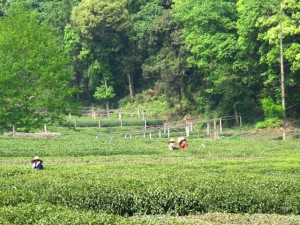 Local celebration not to be missed:
Local celebration not to be missed:
Given tea’s importance in the Chinese culture, it’s no surprise that there is a Shanghai International Tea Culture Festival held annually in April. However, the best way to experience the local process of making tea is visiting tea farmlands, such as the Meijiawu Village in Hangzhou. Only an hour away from Shanghai, it’s where you can cruise the peaceful West Lake, stroll through idyllic tea plantations and buy fresh tea right from the source.
For a more bucolic/green setting I escape here:
Unfortunately, Shanghai is not the best place to enjoy a green environment. As thrilling as it can be, it’s quite challenging to find a peaceful natural escape; most days, it’s foggy and heavily polluted. That being said, People’s Park is the most centrally located park in Shanghai. Given its modest size, it’s not what one would normally expect from a park. However, one of the most fascinating aspects is the Sunday Single Market, where you’ll find parents trading stats of their unwed sons and daughters.
Yuyuan Garden, located in the center of the Old City, is another feasible refuge from the hustle and bustle of Shanghai’s streets. Initially built as a private garden during the Ming Dynasty, it is considered one of the most lavish Chinese gardens in the region. It features rock formations, bridges and alcoves with dragon walls and is generally designed in the Suzhou style, a city known as “the Venice of the East.” It’s without a doubt a photographer’s paradise, especially when confronted with the magnificent blend of old pagodas and new architecture, as seen from the Bund.
The art/music scene is alive and well here:
For the past few years, the grand organizer of the legendary Midi Festival, Beijing’s largest music festival, came to Shanghai to entertain the thousands eager for fine rock, hardcore, alternative and punk bands. Taking over Pudong’s Century Park over a three-day extravaganza at the beginning of May, dozens of local and international bands entertain the roaring crowds. Despite the brutal heat and the constant rubbing of elbows, the bands rock Shanghai, always delivering an epic show.
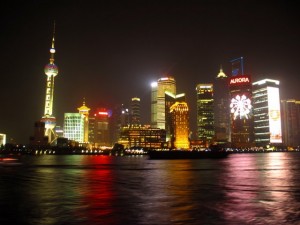 Where the locals get tipsy:
Where the locals get tipsy:
Back in the 1930s, Shanghai was considered the most notorious city in Asia, dubbed as “Paris of the East.” Old Shanghai presented countless opportunities for decadence in its rowdy nightclubs and glamorous venues. That came to an end once the Communist Party came to power in 1949. However, in the last few years, Shanghai has gradually come back onto the party map. With staple clubs such as Bar Rouge and M1NT, there are countless opportunities to toast Gambei (cheers).
Multiple winner of Bar of the Year, Bar Rouge sets the standard for The Bund nightlife. This is the place to be for Shanghai’s hippest crowd. Bar Rouge consists of two parts: the interior modern bar with striking red lights and an outside rooftop terrace overlooking the stunning views of Pudong, the epicenter of modern Shanghai.
An exclusive membership nightclub hovering on the 24th floor high above the city, M1NT also offers spectacular 360° views of The Bund and Pudong. The first thing you notice upon arriving is the jaw-dropping 17-metre long shark tank. M1NT also hosts fashion shows, at which point the bar is quickly turned into a catwalk for the night.
Most ludicrous stereotype about the people here:
Chinese people are short and rude. I found that to be quite the contrary. Firstly, there are an impressive number of incredibly tall people, taller perhaps than some of the tallest Dutch. In terms of manners, the common man will not be incredibly polite, as we know it in the United States; they will brush you off and push you aside. However, when dealing on a more personal level with the Chinese, you will find they care more about etiquette than any other culture you may have witnessed. They fight over who should pay the bill and who should enter the door first. They are also incredibly generous and hospitable. If invited to one’s home, you will be warmly treated as one of the members of the family, and showed around the city. It is part of the Chinese culture to give and show “face” which essentially means to show respect and honor towards your fellow man.
If I had only 24 hours to explore Shanghai I would:
First and foremost, I would start with a few xiaolongbaos for breakfast. They can be found on every corner and are not only delicious, but cheap. I would then head towards The Bund for an encompassing view of Pudong and modern Shanghai. After enjoying The Bund’s extensive promenade, I would head into the Old City to visit Yuyuan Gardens, and perhaps even haggle my way for a few souvenirs.
For lunch, I would walk around the French Concession showcasing Shanghai’s old-romantic world of the 1930s, and stop at one of neighborhood’s quaint restaurants. In close proximity is the artsy district of Tian Zi Fang, which would be a great next stop to relax in a coffee shop and take in some local art. Depending on how much time I have left, I would grab a bite for dinner at Bali Bali, an exquisite Indonesian restaurant.
To end the night, I would have to go back to The Bund, this time for a cruise on Hungpu River; 9pm is the best time to see the electrifying neon lights scattered across Pudong’s skyscrapers.
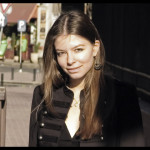 About the Writer
About the Writer
Romanian by birth, but New Yorker at heart, there is nothing Monica enjoys more than traveling and exploring other cultures. Her 20-something relentless quests stem from a long bucket-list, always accompanied by her camera. Follow her adventures around the world on her blog Monica-Suma or on Twitter @MonicaSuma.
Feature photo by trioptikmal
All other photos by Monica Suma
